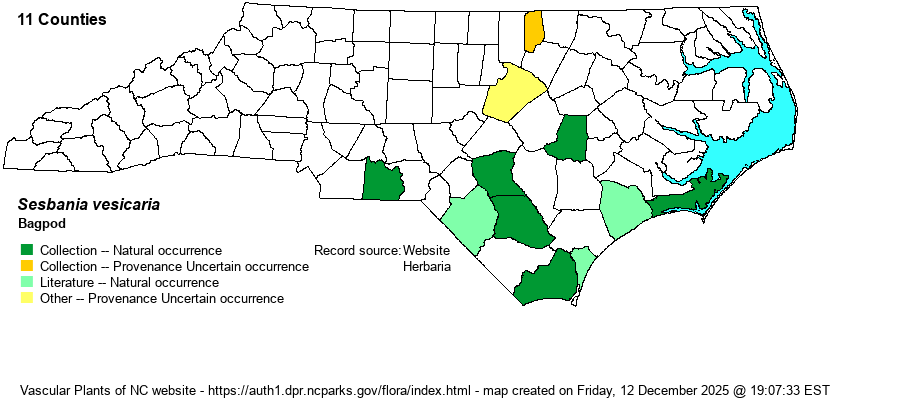| Author | (Jacquin) Elliott | |
| Distribution | As with S. herbacea, this species is of uncertain provenance in NC, though Weakley (2018) cautiously considers both as perhaps native in the Coastal Plain. It is scattered in the southern Coastal Plain, from Carteret County on the east to Anson County on the west. Certainly, as the counites where collected are more scattered than in the other species, the case for this being native in NC is weaker than for S. herbacea. A specimen from Vance County and photos from Wake County in the northeastern Piedmont are presumed non-natural records.
This species occurs from southeastern NC south through FL and west to central TX and OK. | |
| Abundance | Uncommon to infrequent along and near the southern coast. Very rare more than 50 miles from the coast, and probably not native that far inalnd. Probably deserves to be considered as a Watch List species in NC, such as W7 (native but poorly known). | |
| Habitat | As with S. herbacea, this species occurs in disturbed wetlands in the state, mostly in ditches and canal margins. It can occur in marshes, wet fields, and wet thickets. | |
| Phenology | Blooms from July to September, and fruits from August to November. | |
| Identification | This species and S. herbacea are quite similar in overall features. It is a tall and robust annual herb, growing to about 5-7 feet tall, and rarely to 10 feet tall. Though mostly unbranched, it has quite long leaves, to about 8-10 inches long, divided into 20-40 rather small and narrow leaflets. Each leaflet is much larger than on S. herbacea, as they are about 1-1.5 inches long and about 1/5-inch wide, narrowly elliptic in shape. As with the other species, most parts of the plant are smooth. The medium-sized flowers are in small racemes/clusters in leaf axils that reach about 4 inches long. Each of the scattered flowers is bright golden-yellow, considerably smaller than on the other species, and only about 2/3-inch long when spread (and the petals lack purple-brown spotting). In addition, the two species are most easily separated by their pods. In this species, the pod is flattened and short, being only 1.5-2 inches long and about 2/3-inch wide; on S. herbacea, the pods are very long (often 7 inches long) and extremely narrow. These "squatty" pods characteristically hang down from the leaf bases, very noticeable even at a distance. There is still much to be learned about not only the species' provenance in NC but its "native" range and abundance. | |
| Taxonomic Comments | Many or most references, at least several decades ago, named this species as Glottidium vesicarium. There seems to be near universal agreement that it belongs now in the genus Sesbania.
| |
| Other Common Name(s) | Bagpod Sesbania, Bladderpod (used essentially for Staphylea trifolia). The first of these -- Bagpod Sesbania -- is quite appropriate, but as the other species -- S. herbacea -- is usually named as Bigpod Sesbania, these two names are extremely similar (one letter difference)! Thus, most references simply use Bagpod as the common name. | |
| State Rank | S2? | |
| Global Rank | G5 | |
| State Status | [W7] | |
| US Status | | |
| USACE-agcp | FAC link |
| USACE-emp | FAC link |

